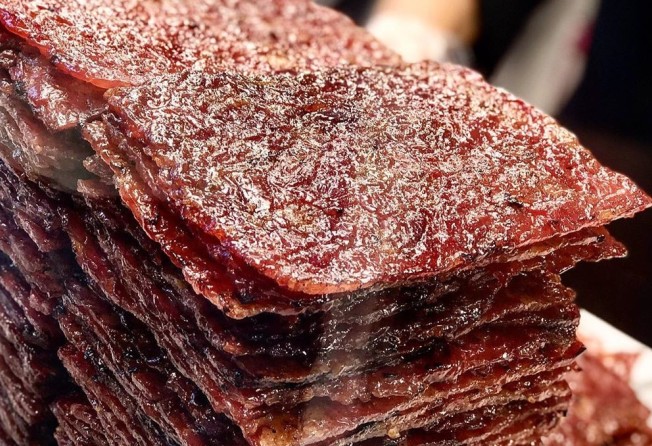View this post on InstagramA post shared by Jun | Jun & Tonic (@jun.and.tonic) on
What is bak kwa, and why do Chinese, Malaysians and Singaporeans crave it at Lunar New Year? Hint: it’s a little like jerky
People pay high prices and queue for ages to get their hands on this salty-sweet dried meat, but where, and how, did it originate?

Among all the well-known Lunar New Year snacks, bak kwa or rou gan is probably among the most famous of them all. Where did this tasty treat, which is similar to jerky, come from?
Bak kwa’s birthplace
Ask any Chinese person and you’ll most likely be told this: bak kwa, which means “dried meat” in the Hokkien dialect, is synonymous with Lunar New Year, and it is almost a crime not to have this moreish snack in your home all through the festive season.
Its origins can be traced by to ancient China, specifically the province of Fujian, during a time when poverty was widespread. Pork (or meat in general) was considered a luxury that not everyone could afford, so it was reserved for Lunar New Year. These succulent barbecued meats are first sliced into thin strips and dipped in a sugar and spice marinade before being air-dried and cooked over a hotplate.
As many Hokkien immigrants from Fujian made their way to the Malay Archipelago (now Malaysia) in the early 15th century to escape a life of poverty, they reputedly brought this delicacy with them. It has since been tweaked to suit local tastes. The Malaysian and Singaporean versions are grilled over charcoal after being air-dried, which gives the meat a smokier flavour. The local version is sweeter than the original.
View this post on InstagramA post shared by TheSaltedHog (@thesaltedhog) on
There are two main varieties of bak kwa in Malaysia and Singapore, minced pork and sliced pork. The minced pork version, which has a higher fat content, is prepared by shaping minced meat into slices before grilling. The sliced version is leaner and tougher as it is made from pork slices that have been cut off from solid blocks of meat.
Modern bak kwa
The choice of meat today extends beyond pork as chicken, beef and mutton are also used, and typically prepared with a concoction of spices, sugar, salt and soy sauce before being air-dried on racks at around 50 degrees to 60 degrees Celsius.
Making this snack can be time-consuming, but machines have helped to save time. When Lim Kay Eng, founder of popular bak kwa shop Lim Chee Guan, opened the store in 1938, a slab of pork cut into thin slices was marinated and dried in the sun – 82 years later, the process remains pretty much the same, except machines are used to cut large slabs of pork and to transport the meat from one production station to another. Everything else is still done by hand, says Benny Lim, the founder’s grandson.
View this post on InstagramA post shared by KLÉSIS Café+ (@klesiscafe) on
The ingredients that have been combined with the meat also vary. Chilli pork bak kwa caters to those who enjoy spicy food – Kuala Lumpur-based company Hock Guan offers a mala flavour for its minced bak kwa this year, while bak kwa made of chicken or beef are alternatives for those who do not eat pork. Duck, crocodile, emu, prawn, ostrich and lobster are among the more exotic varieties of meat.
View this post on InstagramA post shared by Singapore Food Listing (@singaporefoodlisting) on
Other innovations include bak kwa made from premium pork belly (instead of the normal pork hind leg cut) or containing ingredients such as ginseng, cheese, garlic and pineapple, where chunks of the fruit are combined with the meat during production. There’s also a meatless version for vegetarians, where soy or tempeh is used in lieu of pork.
With a growing trend towards healthy eating, bak kwa companies have also been keeping up with the times, producing products with softer textures, lighter colours and less sugar. Bak kwa can also made with turkey or from the less fatty pork loin without any preservatives, monosodium glutamate (MSG) or artificial food colouring, so consumers can enjoy the snack with less guilt.
View this post on InstagramA post shared by HaruCafeGallery (@harucafegallery) on
Bak kwa is commonly sold as thin square sheets, but companies have started to get creative with their presentation as variants such as the “golden coin”, which is bak kwa cut into small circles, appear on the market. You may also come across pig-shaped bak kwa made from kurobuta pork or heart-shaped bak kwa.
Malaysians and Singaporeans often grumble about bak kwa prices rising in the run-up to the festivities. Some even see bak kwa prices as an indicator of inflation. Singaporeans’ preoccupation with bak kwa prices prompted Bloomberg’s Singapore office to release a fun Bak Kwa Index, which tracked prices of the delicacy during the 2007 Lunar New Year. Skyrocketing prices don’t seem to deter locals from buying this sweet and savoury jerky, as can be seen by the snaking queues that form every festive season.
View this post on InstagramA post shared by E M I L Y. T • Singapore (@emily.eatingthyme) on
Maybe it’s the bak kwa’s auspicious red colour that symbolises fortune or its grilled smoky taste that keeps people coming back for more. One thing’s for sure: no price is too high to keep Malaysians or Singaporeans away from this century-old delicacy.
Want more stories like this? Sign up here. Follow STYLE on Facebook, Instagram, YouTube and Twitter .
Where are Singapore noodles from? How are century eggs made? Are French fries improperly named? And what’s the final verdict on where tikka masala was created? With the Origins series, STYLE delves into the often surprising beginnings of iconic dishes or foods, how they’ve evolved over time and the many ways they’re enjoyed today.